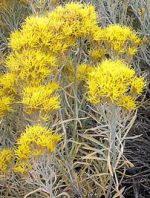
Yellow rabbitbrush is a rounded deciduous shrub and member of the aster family, Asteraceae, that also includes daisy, sagebrush, and lettuce. It is native to western North America and can be found from British Columbia south to southeastern California, and east to north Dakota, Arizona, New Mexico, and Texas. Plants are resistant to drought, grow well in alkaline and saline soils, and do especially well in soils rich in calcium. They are adapted to desert and semidesert conditions and rapidly move into disturbed sites such as burned or overgrazed areas. Yellow rabbitbrush is important for wildlife as a source of both cover and food.
Description: With a deep taproot and many major horizontal secondary roots, yellow rabbitbrush grows 1-5′ tall with many brittle branching stems that are pale in color. The thread-like leaves are up to 2′ long and may be twisted or curved. Tubular yellow disc flowers appear from late summer to fall in bushy clusters of terminal flowerheads less than 2 1/2″ across and lined with sticky yellow-green leaf-like structures, and are followed by an abundance of very small achene fruits tipped with hairs that facilitate wind dissemination. Plants reproduce by seed that do not persist long in the soil and by basal sprouting.
Control: Mulch to suppress seed germination, pull or hoe young seedlings, and pull or dig out older plants before they set seed. Cutting, mowing or burning is not effective because new plants will sprout at the base of old ones. Severe infestations are difficult to control because herbicides are not very effective. For the best results apply 2,3-D during periods of active growth and high soil moisture.